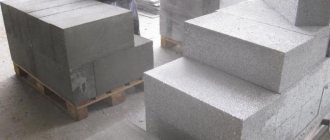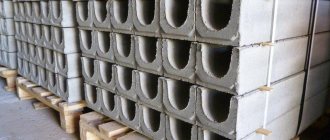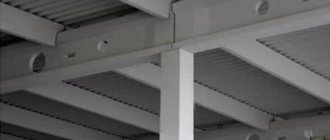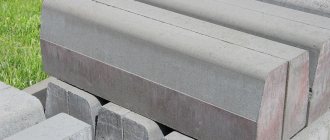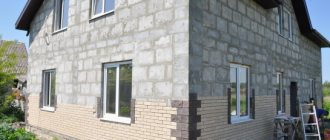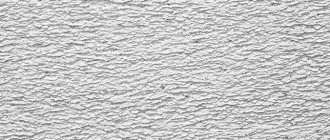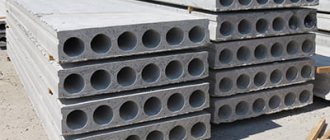And finishing after using this building material is kept to a minimum.
This is due to the fact that the surface of the raw material is smooth and does not require leveling with plaster or putty. Concrete stones are available in different sizes: some of them are relevant for the construction of walls.
Advantages and disadvantages
The blocks are made using the vibrocompression method. Their rigid ribs can withstand various loads and negative impacts. Therefore, they are considered indispensable in the creation of large objects and other similar structures.
Main advantages:
- Economical. The elements are assembled into a single object quite simply and quickly. This means that the developer significantly saves money on attracting additional workers.
- Low level of thermal conductivity.
- Good sound and heat insulation properties.
- Resistant to fire and sudden temperature changes. The products are excellent for construction in hazardous areas and in regions with harsh climates.
- Durability. The finished structure will last up to 100 years if the assembly technology has been taken into account.
- Resistance to moisture, corrosion, aggressive environments. The blocks are not afraid of soil with a high level of acidity.
- The products do not cause the occurrence of fungus, dampness, mold, or dangerous microorganisms.
- Many shapes and sizes. Enterprises produce blocks with various design parameters.
Minuses:
- Heavy weight. The use of special equipment is required to move the blocks.
- Price. Sometimes the choice of reinforced concrete blocks is not justified in economic terms during the construction of small-sized objects.
Production
Production is carried out by vibrocompression of a semi-dry composition. The components are placed in special molds, left for two hours, and then pressed together under the influence of vibration. Setting occurs after 3 hours. The use of high-quality raw materials allows us to produce cement products with specified characteristics.
The prepared raw materials are used in construction after aging for 50 days. An external sign characterizing strength is the presence of marble stains on the surface of the product. They are absent if the proportion of ingredients is violated or the manufacturing technology is not followed.
Types and sizes
Reinforced concrete blocks are divided into several types depending on their purpose and design features. Each individual group has its own parameters.
Solid blocks
These are foundation building blocks, or FBS for short. Purpose - to create foundations that can withstand strong vertical loads. They are made of concrete and reinforcing frame.
Peculiarities:
- Density. For FBS it reaches 2400 kg/cubic meter. m, which is the highest figure on the market.
- Frost resistance. Solid blocks have an F200 rating. This is a very impressive parameter. The material can withstand up to 200 freezing and thawing cycles.
- Dimensions. The length of the product is 88 cm, width - 30, 40, 50 and 60 cm, and height - 58 cm.
- Life time. The products will last at least 150 years.
- High thermal insulation. The blocks are laid with glue, so the seam is much smaller compared to installing bricks with mortar. Therefore, the indicators increase by 2-3 times.
- Good sound insulation. Noises up to 50-70 dB do not enter the room.
Reference. Solid reinforced concrete blocks have a waterproof rating of W2. This means that the finished foundation will not be washed away by groundwater and melt water.
Reinforced concrete blocks with special grooves
Foundation blocks with cutouts, or FBV for short, are products for private and professional construction, additionally equipped with channels for the installation of beams, lintels, and utilities. Manufactured from high-strength concrete that meets the requirements of GOST 13579-78. They are light, heavy and dense.
Peculiarities:
- Strength. The indicator is divided into classes based on the compressive strength of the product. For construction, light and heavy concrete from B3.5 to B15 are acceptable, dense concrete - B12.5.
- Frost resistance. No different from FBS. Therefore, use in northern regions is acceptable.
- Dimensions. The length of the blocks is 0.88 cm, width - 30, 40, 50, 60 cm, and height - 58 cm.
- Life time. At least 160 years old.
- Good thermal insulation performance. Typically, FBVs are installed in basements. They retain heat well and prevent communications from freezing.
Important! The grooves are suitable for additional concreting. In this case, you do not need to wait until the solution hardens. It perfectly fixes all structural elements and does not slow down the construction process.
Types of concrete blocks
In addition to FBS and FBV, there are also FBP. These are hollow foundation blocks, more reminiscent of UDB. They are distinguished by the presence of square holes that are not through, but plugged. The notches are vertical and horizontal.
Options:
- width - 60 cm;
- height - 58 cm;
- thickness - 10 cm;
- weight - from 200 kg to 3 tons;
- the pitch size of the pyramid-shaped holes is 60 cm (if the block length is 6 m).
The blocks are made of heavy silicate concrete or slag concrete. The scope of application is the creation of foundations for large mechanized equipment, rolling and metalworking machines.
Important! FBV blocks are prohibited for construction on wet and viscous soils. The fact is that such soil will penetrate into the holes and gradually pull the building along with it.
Varieties based on material of manufacture
Raw materials influence the technical and operational characteristics of the final product. Depending on the concrete used, reinforced concrete blocks are:
- Heavy. The raw material is concrete grade M200 or M400 with a density of 2400 kg/cubic meter. m. The weight of one finished product is from 300 kg. The final product has high thermal conductivity and frost resistance. If the enterprise uses granite crushed stone as a filler, then the blocks can be used for construction in acidic soil.
- Light. Raw materials - concrete grade M100 or M150 with a density of 1800 kg/cubic. m. The weight of one block varies between 300-1630 kg. Suitable for use in dry soils.
- Expanded clay. The raw material is expanded clay concrete with a density of 1800 kg/cu.m. m. The weight of one product is from 260 to 1500 kg. It has high thermal insulation properties, but low resistance to sudden temperature changes and moisture. Therefore, it requires the creation of high-quality waterproofing. The blocks are suitable for the construction of light structures.
Which one is better to use?
In order to choose the right type of concrete for a strip foundation for a particular building, you should take into account the characteristics of different classes and brands of mixtures. They are presented here:
| Concrete brand | Class (grade) of concrete by strength | Application of concrete |
| BSG V 7.5 F50 W2 P3 | B7.5; M100 | Used for preparatory work |
| BSG V 10 F50 W2 P3 | AT 10 O'CLOCK; M150 | For arranging strip foundations during the construction of small buildings |
| BSG V 12.5 F100 W2 P3 | B12.5; M150 | For pouring tapes under light oversized buildings |
| BSG V 15 F100 W4 P3 | B15; M200 | For grillages and screeds, as well as strip and slab supports for buildings |
| BSG V 20 F150 W4 P3 | IN 20; M250 | For monolithic foundations (strips and slabs), for pouring floors with insulation |
| BSG V 22.5 F150 W6 P3 | B22.5; M300 | Used in the construction of load-bearing reinforced concrete structures, can be used for floor screeds with a high strength index and heating |
| BSG V 25 F200 W8 P3 | B25; M350 | This material is used to create reinforced concrete load-bearing elements that will be operated under increased load |
| BSG V 30 F200 W8 P3 | B30; M400 | The foundations of cottages are constructed from this material when building on soft soil, and for the foundations of apartment buildings above 3 floors |
Concrete from M500 and above is also used in the construction of country cottages, but they are practically not used in the construction of private houses.
A trademark is a type of concrete mixture sold ready-made in construction companies and delivered to the construction site using special equipment - concrete mixer trucks. The mixture produced by the construction organization must be delivered no later than an hour and a half after mixing.
During construction on a site remote from the city, where it is impossible to supply the finished mixture within the specified time frame, concrete is prepared directly at the construction site. The components are combined in such proportions to obtain a material with the appropriate characteristics.
Average prices
Prices depend on the manufacturer and may vary significantly in different regions:
| Concrete grade | Price per cube |
| M50 (B3.5) gravel | 3500-4000 |
| M100 (B7.5) gravel | 2900-4000 |
| M150 (B12.5) gravel | 3000-4200 |
| M200 (B15) gravel | 3200-4400 |
| M250 (B 20) gravel | 3200-4500 |
| M300 (B22.5) gravel | 3300-4600 |
| M350 (B25) gravel | 3800-4700 |
| M400 (B30) gravel | 3700-5100 |
| M450 (B35) gravel | 4200-5500 |
| M500 (B40) gravel | 4400-4600 |
| M550 (B40) gravel | 4200-6000 |
| M600 (B45) gravel | 4500-4900 |
| M700 (B50) gravel | 5400-5500 |
| M800 (B60) gravel | 5700-5900 |
| M100 (B7.5) granite | 3500-3800 |
| M150 (B12.5) granite | 3700-4000 |
| M200 (B15) granite | 3900-4100 |
| M250 (B20) granite | 4000-4300 |
| M300 (B22.5) granite | 4299-4400 |
| M350 (B25) granite | 4300-4600 |
Features of choice
Before purchasing reinforced concrete blocks, it is important to determine the strength indicators, density and uniformity of the material, performance characteristics - how resistant the product is to adverse environmental influences.
The purpose of the construction project, the magnitude of the load of individual structural elements (for example, walls, second floors), and the type of soil are taken into account. After analysis, the data obtained is compared with the technical characteristics of concrete products. If all parameters are comparable, then the product is purchased.
Attention! When choosing, you should pay attention to the quality of the block. To do this, the buyer visits the company and examines the product. Be sure to inquire about the availability of documentation confirming the production of blocks in accordance with GOST. Also, the products must be the same size. But a deviation of no more than 5 mm is permissible.
Installation of blocks
No different from laying ordinary bricks. However, installation of reinforced concrete products requires compliance with certain rules.
- During installation, a seam is created for applying the solution. Its dimensions range from 10 to 12 cm.
- To increase the strength of the walls, the structure is reinforced with reinforcement.
- The laying of blocks begins from the corners to achieve maximum accuracy of the parameters specified in the design documentation.
- If it is necessary to leave voids, then leave a board in their place. This way the solution will not get into them. The board necessarily moves with the appearance of a new block layer.
- The creation of basement walls uses a similar technology. But the top row is tied to the base of the building or the floor.
Reference. To work with concrete products, a specific set of tools and solution are prepared. The mixture is made from the components specified by the manufacturer.
Step-by-step instructions for laying the foundation
To begin laying concrete blocks for the foundation, dig a pit (trench). To ensure that installation does not cause inconvenience, it is important to find out the dimensions of the FBS blocks (Table 1) and dig a wider trench. The bottom is cleared of rock, irregularities are smoothed out, and the base is filled with sand. In sandy soil it is not advisable to do this work. In order for the laying of a concrete block foundation to be successful, it is necessary to prepare the foundation.
Preparing the base
Figure 5 - Concrete block foundation
For a sand base you will need a wooden beam, 50 - 100 mm in height. Make the sand embankment 200 mm wider than the base of the foundation. After installing the wooden beam (be sure to check the evenness of the surface), moistened sand must be poured inside the frame and compacted.
To increase the base area, the initial row is laid wider than the main part (you can use FL foundation slabs or fill the base with a monolithic strip foundation).
The gap between laying slabs can reach 700 mm. Next, lay the first row of FBS in such a way that the seams located vertically are above the pillows.
Laying blocks
To begin installing a foundation made of FBS blocks, you need to understand how to lay the blocks. Installation work begins with marking. The stakes are installed according to the drawing, and the thread is pulled along them. To make laying the row easier, first place the blocks at the corners and intersections. Fill the vertical seams with mortar or tamp down as much as possible with earth. The space between the blocks that appears during installation is filled with concrete and leveled until a monolithic insert is formed between the blocks.
The layer of mortar between the top and bottom rows must be at least 15 mm. Vertical seams are tied with a layer of concrete 250 - 600 mm. To strengthen the dressing between the rows, use reinforcement. During laying, do not forget to make a hole for the sewer pipes.
Making at home
Self-production of concrete products slightly reduces financial costs. A person is confident in the quality of products freshly prepared with his own hands. But you will have to wait until the solution hardens. This will take at least 1 month.
The process looks like this:
- Preparation of components. You will need Portland cement, sand with a fraction of 1.5 mm, and water. The proportions are indicated in the regulatory documentation of the block brand of interest.
- Preparation of the solution. All components are mixed using a vibrating machine to a thick consistency. If the mixture is too liquid, the product will have low strength values.
- Filling. The solution is formed in special containers, and its top is leveled with a trowel. To increase strength, the block is reinforced: a reinforcing mesh is installed in the mold.
- The final stage. The solution must dry. It will take 3 to 5 days. Then the product is removed and sent for additional drying. The block gains strength within 21 days.
Important! The quality of concrete products will depend on the brand of concrete. When mixing it, you need to study the instructions on the production packaging. A minimal deviation from the recommended proportions will lead to damage to the entire batch. And this, in turn, will affect financial investments.
How to mix concrete
When pouring the foundation, you should soberly assess your strengths and capabilities. For a large foundation, it is advisable to order ready-mixed concrete.
When the amount of work is small, many people prefer to mix concrete themselves. For this purpose, construction mixers or small concrete mixers are used.
Usually, water is first poured into concrete mixers, then aggregates (large ones, followed by small ones) are poured into the running concrete mixer, and only after that cement is added.
When working with a construction mixer, it is sometimes preferred to first mix the cement with aggregates, then gradually pour in water.
You can also mix the concrete mixture with a shovel. To do this, lay out cement and aggregates on a level area, mix them, turning them over with a shovel, then gradually add water and mix.
When making your own foundation, the quality of installation is of great importance. In private construction, concrete is preferred, which is laid “by itself”. To obtain such concrete, use plasticizers and superplasticizers, which allow you to obtain high-quality, dense and durable concrete without unnecessary labor and saving costs on materials.
Marking of reinforced concrete products
Any reinforced concrete products are marked according to GOST 13015.2-81. The marking consists of three formats: a marking inscription, a special information signature, and special installation marks.
First group. The brand consists of letters and numbers. They, in turn, are divided into three groups: type of product, class of reinforcement plus type of concrete and load-bearing capacity of the block, special properties of a particular component. Additionally, the markings include dimensions. For example, FBS 20 6 4 TP will be deciphered as follows:
- FBS - solid foundation block;
- 20 - length in decimeters;
- 6 — width in decimeters;
- 4 - height in decimeters;
- T - heavy concrete was used;
- P - porous (concrete properties).
Second group. The information inscription includes information about the date of manufacture and the weight of the concrete products. The last parameter is indicated if the block exceeds 500 kg. Usually below this indicator the mass is not indicated. Small-piece products are marked only 10% in one batch.
Third group. Mounting marks indicate the main locations for mounting blocks. This is the center of gravity, the area for slinging work, the top of the element, and so on.
Reinforced concrete blocks are truly high-quality and durable products for the construction of a wide variety of objects. They deservedly occupy a leading position in the list of building materials. Before purchasing, it is important to determine the purpose of the structure being built in order to select the optimal type of reinforced concrete products. Additionally, pay attention to the product labeling, technical and operational properties, and also read the accompanying documentation.
Classification by type of raw material for the production process
The following types of building blocks are deservedly popular and in demand among individual developers:
Types of thermally efficient blocks.
- Ceramics are large-sized mounting elements that are actively used for the construction of internal and external walls during the construction of buildings.
- Gas silicate piece material - wall blocks with a cellular structure. For their production, materials such as cement, quartz sand, lime, water, gas and vapor-forming additives are used. Bricks of this type have low weight and at the same time sufficient strength. The most popular brick sizes are 600/200/300.
- Expanded clay concrete is a block of concrete mortar with expanded clay additives. Such structures demonstrate enviable noise insulation, retain heat, have increased strength characteristics and are used for the construction of walls, external partitions inside the building, as well as load-bearing structures of the building.
- Foam concrete is lightweight bricks made from a mixture of construction foam and specialized cement. Elements with dimensions of 200/400/200 are popular in the construction of low-rise buildings.
- Textured blocks - such products are expanded clay concrete, only lined on all sides. Such building material is purchased for aesthetically attractive exterior decoration of the building.
